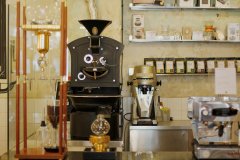Coffee grinding: only the most suitable, not the most standard

For professional baristas, please follow the coffee workshop (Wechat official account cafe_style)
Usually there are coffee shops that sell coffee beans to help customers grind beans and grind them into a suitable thickness according to the equipment used by customers. generally speaking, there is no deep knowledge, of course, what kind of cooking method to grind what kind of thickness is also a topic, but if you are not ready for a bean grinder, leave it to the store to solve! If you have your own bean grinder, it's worth discussing!
The most common bean grinder is a blade rotary electric bean grinder, which can be bought for 5-600 yuan, but it is worthless except for convenience and is a machine for lazy people, because the size of the ground beans is very uneven and does not meet the requirements of cooking coffee, so it is not recommended. The better choice is a household electric bean grinder with adjustable thickness, but the price is more expensive, about 2 to 3000 yuan. If it is a business model, from 5-6, 000 yuan to 100, 000 yuan, depending on the actual needs, if the budget is not so high, small adjustable hand bean grinder is the only consideration, the price of 5-800 yuan is cheap and practical, the only disadvantage is that the speed is slow, many people will be slow to drink. But when many people drink, it is not interesting to entrust the heavy responsibility of grinding coffee to the person who drinks coffee.
Every kind of cooking equipment has a suitable thickness, but it is not absolute. The size of the particles will be required because of the cooking method, not the coffee beans or the formula. For example, the "filter pot" (that is, the black tea maker with a handle connected to the filter), it needs thicker particles because the handle is too fine to press down. If you don't want the handle, use filter paper or screen to filter coffee grounds instead. You can use the most professional "cup test" and enjoy the coffee with different thickness, and the brewing time of the filter pot is longer because of the coarse particles, and the brewing time can be shortened with the finer particles, but there is nothing absolute, remember! What you think is good is good, what other people say is just a reference!
Remember to ask the shop owner how to operate and adjust when you buy, and try to grind it to determine the quality when you decide to buy it. if it is an adjustable bean grinder, ask him to adjust it to the usual scale for you. After buying it home, you can try to cook it up and down according to the scale adjusted by the store, so as to find out the scale that you think is suitable.
There are four common cooking methods in the market, such as siphon tube, follicle, mocha pot and espresso machine. basically, the thickness of grinding is proportional to the time it takes for water to pass through coffee, that is, the shorter the cooking time, the finer the grinding. The longer the time, the thicker the grinding. In this way, the siphon type takes a longer time, the particles are thicker, the follicle type takes the second place, the mocha pot is again, and the espresso machine is the thinnest, in which the particle thickness uniformity is the most stringent with the espresso machine, because under several atmospheric pressure, the coffee ingredients will be pressed out instantly, if the particle thickness is uneven, there will be the problem of flow bias, resulting in insufficient extraction in part and excessive extraction in part. The rest of the cooking methods, as long as the particle size is not too much, the impact is not very obvious, but as much as possible!
Important Notice :
前街咖啡 FrontStreet Coffee has moved to new addredd:
FrontStreet Coffee Address: 315,Donghua East Road,GuangZhou
Tel:020 38364473
- Prev

Novice beginner | choose coffee beans from "tasting"
For professional baristas, please follow the coffee workshop (official Wechat account cafe_style). When introducing how to choose coffee beans, most books require looking at beans, smelling beans, touching beans and even biting beans. Although these are important, the prerequisite is whether the taste of coffee roasting is right for you. Every roasting stage is due to the baking master's knowledge of coffee roasting.
- Next

Coffee maker (1) Don't rush to compare coffee machines, you must give priority to electricity and water!
Professional barista communication please follow the coffee workshop (Wechat official account cafe_style) Espresso to uplift your spirit, knock your heartbeat, surge your blood, drive your soul, occupy your body, perfect your present! In Europe, coffee is a good way to replenish the spirit, stop at the bar, look up, drink up, check out and go out! No muddling, leisure time
Related
- Beginners will see the "Coffee pull flower" guide!
- What is the difference between ice blog purified milk and ordinary milk coffee?
- Why is the Philippines the largest producer of crops in Liberia?
- For coffee extraction, should the fine powder be retained?
- How does extracted espresso fill pressed powder? How much strength does it take to press the powder?
- How to make jasmine cold extract coffee? Is the jasmine + latte good?
- Will this little toy really make the coffee taste better? How does Lily Drip affect coffee extraction?
- Will the action of slapping the filter cup also affect coffee extraction?
- What's the difference between powder-to-water ratio and powder-to-liquid ratio?
- What is the Ethiopian local species? What does it have to do with Heirloom native species?

